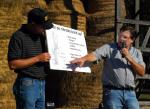COLUMBIA, Mo. – The recent discovery of the emerald ash borer in Kansas City is a surprise and concern. No one expected it to show up that far west. This unwelcome and invasive beetle is a threat to all untreated ash trees, but it’s a crisis in slow motion.
Related radio news story by Debbie Johnson. For downloadable broadcast-quality audio, contact Johnson at 573-882-9183.
Ash trees have no natural defense against this insect, which destroys the vascular tissue under the bark, cutting off water and nutrients to the tree. The insect usually starts at the top of the tree and moves down the trunk with each succeeding generation of borers. It can take several years for EAB to kill a large tree.
Insecticide treatment is the only effective way to protect an ash tree, but there’s no reason to throw money at the problem too soon, said Hank Stelzer, forestry specialist for University of Missouri Extension.
“If a home is within 15 miles of a known location of EAB, then you need to be thinking about protecting that ash tree, especially if it is providing shade for your house,” Stelzer said.
Treating for EAB takes money and commitment. Once treatment stops, the ash borer will be back.
Homeowners can purchase one type of treatment. Imidacloprid, a nicotine-derived insecticide, is available to homeowners at home and nursery centers. The label will identify it as 12-month tree and shrub treatment.
“It’s what we call a soil drench. It’s applied at the base of the tree only and not under the tree’s canopy,” he said. “That’s an annual treatment that needs to be done in early spring.”
A professional arborist is required for the other type of treatment, because only a pro can inject insecticide directly into the tree. Stelzer said this option is more expensive but provides protection for two to three years. Spring is also the best time for this treatment.
Be aware that some people may try to take advantage of homeowners’ worries about their ash trees.
“You’re going to get folks knocking on your door saying they can protect or save your ash tree, but homeowners don’t need to be pressured into doing something right now,” Stelzer said. “Any treatment now would be a waste of money. Trees are preparing to go into their winter rest. The larvae have about finished their feeding and they too are going into their rest period.”
Stelzer suggests homeowners do their homework first. “The Missouri departments of Conservation and Agriculture can help determine if a home is in a known EAB area.”
If EAB is found near your home, Stelzer suggests contacting an arborist with an International Society of Arboriculture rating. They’re trained and know how to identify EAB. “A trained professional can help you decide what to do next,” he said.
The emerald ash borer can move only a few miles on its own. Unfortunately, humans expand its range by transporting infested firewood, nursery stock or anything made from ash. A harsh lesson learned already by several states. Since EAB began killing ash trees in Detroit in 2002, it has spread to 16 states and killed tens of millions of ash trees in the United States and Canada.
Protecting trees and slowing the spread of this green menace will require everyone’s cooperation. The Missouri Department of Conservation reminds everyone:
- Never take firewood with you.
- Only use local sources of firewood.
- If you have transported firewood, burn it thoroughly.
Slowing the advance of EAB is also important for protecting forests and urban tree populations. Ash trees are not as predominant in Missouri’s forests, but they are an important part of city parks and neighborhoods.
“Ash trees only make up about 4 percent of state’s forest trees, but we have a lot of green ash in Missouri towns and cities because they were used to replace elm trees that were killed by Dutch elm disease,” Stelzer said.
If your home is not near an EAB area, there’s plenty of time to evaluate landscapes and make decisions. Diversity is your best protection against disease and insect problems, Stelzer said.
“You don’t want to have all ash trees in your yard, or all walnut trees. You don’t want to have more than 20 percent of one kind of tree in your yard,” he said. “Like investing in the stock market, you want to diversify your landscape portfolio.”
The Missouri Community Forestry Council, Master Gardeners and Master Naturalists can help homeowners make decisions about adding or replacing trees in their landscape.
While EAB is crisis in slow-motion, growing a tree from a sapling is an endeavor of decades. Stelzer urges homeowners not to procrastinate.
“The old adage is: The best time to plant a tree is 50 years ago. The second-best time is now.”
More information:
Read more http://extension.missouri.edu/news/DisplayStory.aspx?N=1497





